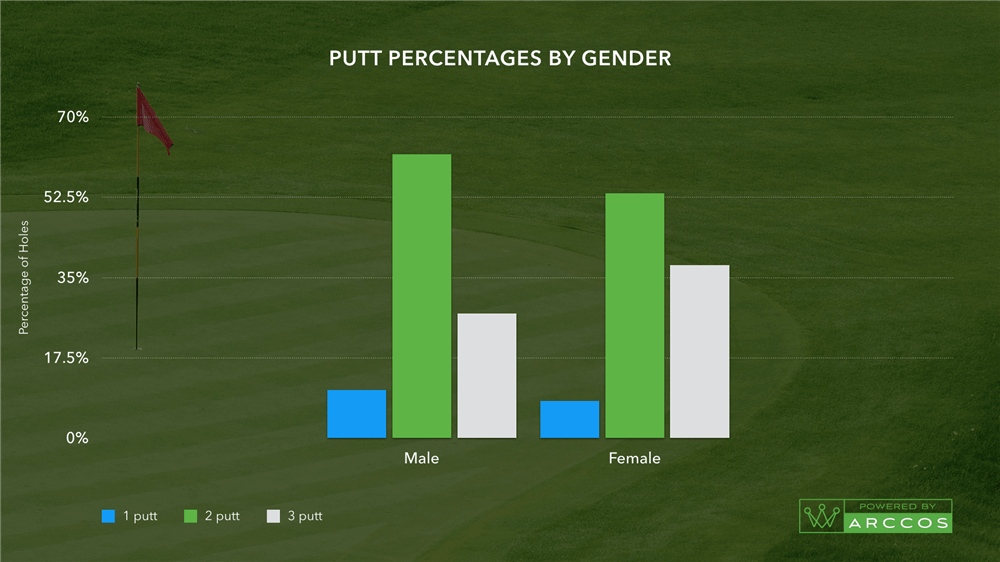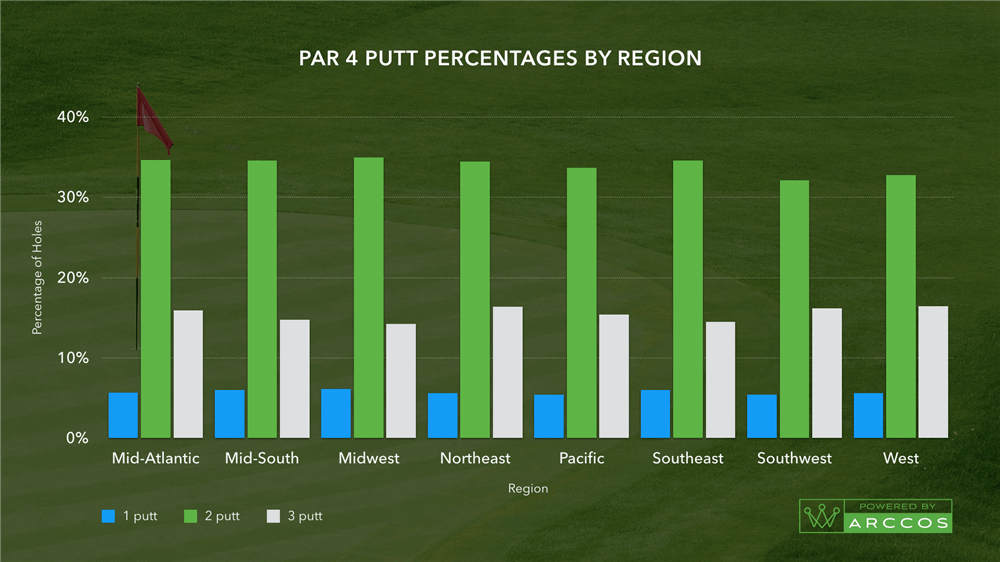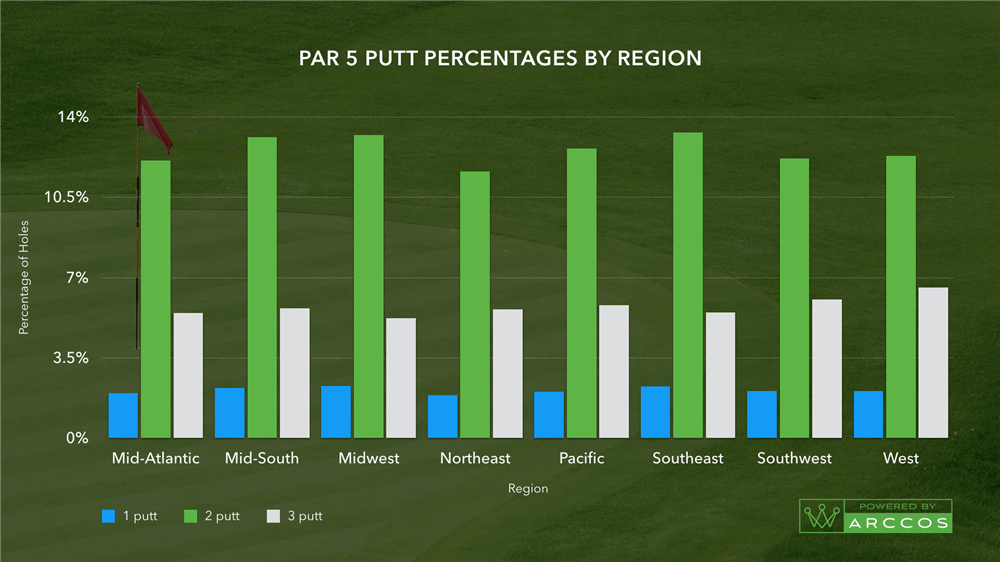Want to be a better putter?
How many times after a round have you muttered: “If I could’ve have made just a couple more putts…?” Would you have broken 80, 90, 100, or whatever your magic number is?
We’ve all been there. Probably recently.
Lost in the fascination with the Strokes Gained analysis and methodology (which suggests the farther you hit it, the better off you’re going to be) is the fact that competent putting saves rounds. There’s a correlation between good putters and good golfers.
We have the data to prove it.
We’ve partnered with Arccos Golf, creators of the industry’s leading golf performance tracking platform, to examine putting statistics throughout its community and vast database. Today we want to uncover some putting truths from the Arccos Community. The goal is to provide everyday golfers with some putting improvement strategies that are just a bit more robust than “practice more.”
About The Data
Before we get to the data, here are a couple of quick notes about its origins:
- Putting data was pulled from Arccos’ extensive database of more than 50 million shots.
- The data utilized in this report comes from golfers with a minimum of five rounds played on the Arccos platform.
Overall Putting By Handicap
The data suggests that while it’s true the lowest handicap group of players covered in this study (+5 through 1 or “Scratch or Better”) are indeed the best putters, they aren’t the most consistent. When considering two-putt percentage, our group of 1-4 handicap players (for the sake of this study, let’s call them low single digit) are the most consistent. Our Low Single Digit group two-putts 68 percent of greens as compared to our Scratch or Better group, which two-putts only 64 percent of greens.
Perhaps more interesting, the Low Single Digit group is also less likely to three-putt than the Scratch or Better golfers. In fact, the Scratch or Better group three-putts at a similar rate as the group of 4-10 handicappers included in the study.
What does this mean? At a minimum, it raises the question of whether it’s better to play conservatively for the sake of consistency and preserving score or take a more aggressive approach with the understanding it may lead to a higher percentage of thee-putts.
The Arccos data suggests that the lowest handicap golfers tend to be more aggressive. Do better players attempting birdie putts with the mindset of back of the cup instead of cozy? Could this approach help lower your handicap?
Average Number of Putts After GIR
Not surprisingly, the average number of putts per green in regulation increases steadily with handicap. There are two reasonable assumptions that likely explain this:
- Better golfers are generally better putters.
- Better golfers hit better shots into green leaving themselves with less ground to cover with the putter.
The Ideal Approach range
As we suggested above, putting performance isn’t tied solely to what happens on the green. Often, your putting stats are influenced by the positions you put yourself in off the tee and with your approach shots.
Standard methodology, perhaps even the conventional wisdom, suggests that you’re best served by managing your game such that your approach shots come from as close to the green as possible.
For amateur golfers, the data from Arccos suggests otherwise.
Without question, the approach range from which golfers in the Arccos community putt best after hitting in from is 150-200 yards.
On par 3s and 4s, the highest percentage of two-putts and lowest percentage of three-putts come after users hit their approach shots from 150-200 yards.
On par 5s, approaches from inside 100 yards accounted for the most two-putts, but it’s notable that more birdie putts (counted as one-putts in our study) came from the 150-200 range.
Putts Per Green in Regulation By Approach Distance
Overall, the lowest number of putts (2.12) following a Green in Regulation come from the 150-200 yard range.
So, what does this mean? For starters, it should move course management a bit higher up your priority list. Hitting the approach shots from a distance that allows for a full swing was likely a benefit for the golfers included in the study.
While it’s surely not going to hurt you much to hit your approach shots from inside 100 yards – after all, the range accounts for quite a few one and two-putts – the 150-200 yard range allows for a full swing, and is still manageable for a large percentage of golfers.
Regardless of skill level, playing to areas of strength is going to help lower scores. The Arccos data suggests that 150-200 yards is the most favorable range.
The Takeaway: Two Key Strategies
The Arccos putting data suggests there are two areas of focus that can help improve your putting stats and ultimately lower your scores.
- Be aggressive on birdie putts. While the temptation may be to avoid mistakes, the data suggests better putters aren’t always thinking cozy. They go for it.
- Manage your approach distances. Closer to the hole isn’t always better. Shots from 150-200 yards produce the highest rate of one-putts and the lowest rate of three-putts. For most, a full swing with a middle iron will produce better results than a half swing with a wedge.
Other Arccos Putting Stats
Now that we’ve reviewed what you can control, let’s look at some of the Arccos data that provides insights into aspects of the putting game over which we can’t control.
Putting Performance by Age
The younger you are, the more likely you are to make one-putts. High school and college-aged players have the highest percentage of one-putts – one-putting nearly 12% of greens. That age group also three-putts less than any other age group included in the study.
When it comes to average putts per hole, data suggests that putting performance rises for young professionals (age 22-28) but trends downward as age increases. Putting performances peaks between the ages of 50-59.
Presumably, putting performance correlates to the number of rounds played. Simply put, the more you play, the better you putt – and it’s been long documented that the young professional age group plays less golf than others.
Putting Performance by Gender
The Arccos data suggests that men are better putters than women, but not by a significant margin.
Women average 2.2 putts after a green in regulation and 1.65 putts per hole overall compared to 2.1 putts after a GIR and 1.58 putts overall.
On average, men three-putt 27% percent of the time while women three-putt 38% of the time.
Putting Performance by Geographic location
When diving into golf performance data, it’s always interesting to examine geographical data. Because of seasonality, performance data often skews for locations in which golf can be played year-round.
Overall, golfers in the northeast are the worst putters. The average more putts per hole than any other geographical region noted in the study.
On average, Midwestern golfers putt the best. They one-putt more than 11% of greens – or roughly two per round.
We’ve also broken down regional performance for par 3s, par 4s, and par 5s.
Just the Beginning
As you might imagine, information gathered from the Arccos community can offer tremendous insight into the amateur game. In future posts will be examining other facets of on-course play gleaned from Arccos and Arccos Driver.
For more information about those products, visit ArccosGolf.com.





























Les Devitt
7 years ago
Love the study, very comprehensive at all levels of capability. It would be an interesting study to look at the total length of last putts across the same sample of golfers. Criteria would be:
15 foot max.
Tap ins count for 2 ft.
3 putts count for -4 ft.
Total number of feet for last putts would be measured across all skill levels. Point is in golf the longer total feet of your last putts the better your score.